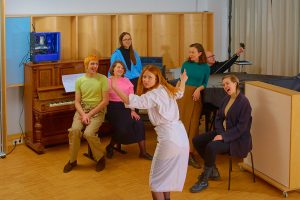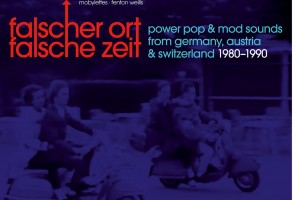“I’m interested in introducing alien sounds.”
Paul McDevitt and Cornelis Quabeck, who run (with David Hubbard) the art music imprint Infinite Greyscale, met up with Holly Herndon in Berlin for an exclusive Kaput chat about her new album “Platform” (4AD / Beggars Banquet), the different audiences she is approaching with her music, her approach to the dance floor and the physicality of her music.
(Herndon and McDevitt and Quabeck are no strangers to each other, in 2014 Herndon released the well received 10-inch “Body Sound” on Greyscale.)
The album sounds terrific. We think it’s going to be a big hit. It seems to be this very shiny, positive pop record, but with a lot of content – that sort of album you’d have to dig into a lot before it reveals itself.
I hope it’s not a one-listen kind of thing. It certainly took a long time to make.
First off we wanted to ask you about audiences and playing live, because you seem to be playing a lot of festivals and clubs these days, places where there is an audience that is there to be entertained, like fish waiting to be fed. On the other hand you have works like the one we released, “Body Sound”, which seems much better suited to a more sober or perhaps more reflective audience, and maybe a different environment such as a gallery. Do you see the two things as offerings for different kinds of listeners? Is there a conflict there in terms of the music you make, or are they quite cross-pollinating?
I think they’re cross-pollinating. I have to take context into consideration because there’s a different attention span in different places. I have played “Body Sound” in places with a shorter attention span. I just have to play a shorter, truncated version of it, or parts of it. I like to present similar material in extremely different locations because I think I learn more about the work that way somehow, but it’s all about attention span. I don’t want to lose people and I don’t want to turn them off. I want to give them just enough to the point where they’re kind of questioning it, but I also want to give them an entry point so that they don’t feel alienated. I don’t want to ruin anyone’s evening! That’s not what I’m out to do.
Some people take pleasure in that.
I know, and I did that for a while. I spent plenty of time in noise communities, where I was like, “how extreme can I be, how puritanical can I be in this one way?” But that’s not what I’m interested in. I’m interested in communicating with people, I’m interested in getting ideas across and not alienating people. I’m interested in introducing alien sounds, and alien aesthetics, but I’m not interested in alienating people.
We’ve all seen artists make quite boring performances using their laptops. Oftentimes music we’re very fond of can be quite disappointing when realized in the flesh. One of the engaging things about your live performance is that, up to a point, the audience can see how you’re building a track. From your days as being in the audience, or in your clubbing days, were there any revelatory moments for you in terms of the laptop performances you saw?
When I was clubbing I was never really interested in the performer. I was interested in the dance floor, and the dance floor dynamic and the euphoria of the dance floor. I started getting really interested in performance dynamics more when I went to Mills (College, Oakland, CA) and started thinking about the laptop as an instrument to be played. A lot of people complain about it being disembodied or being boring like you were saying – you can’t tell what’s going on – so that’s when I really started thinking about how to make it more engaging. That’s when I started using the voice, not only my own but other vocalists, and started playing around with the pick-up microphones – trying to find ways to make it feel more like an instrument, even though I’ve always considered it be an instrument in and of itself. Again, sometimes it’s nice to give people entry points. It’s the same with combining experimental alien sound with pop music – allowing people a way into your work.
Is that similar to creating a bond of trust between you and an audience?
I think so. You create an empathy. There’s an audience / performer empathy. If you understand what the performer’s intent is – and that can happen through mechanical gesture or seeing someone vocalise – then your mirror neurons begin firing, you understand the intent of the performer and there’s an empathy that’s built between the performer and the audience. I think that’s a really important, powerful thing. I don’t imagine myself to ever be one of those performers that gets up and pretends the audience isn’t there. It’s not like I’m a hype woman and I’m like, “heyyy!!!” (throws hands up in the air) – it’s not like that, it doesn’t have to be like that. But I am interested in reeling people in because I like to think of sets as… my sets can be really emotionally diverse. They can take you here, then take you there, and they can kind of take you on this trip, and no one is going to go on a trip with you if you don’t give them the tools to go with you first.
Do you have to start the car slowly as well?
No, I don’t start with something necessarily easy…
When we saw you play a couple of years ago it was like you were building, with building blocks, the first piece, using your voice. And then there was a logic to how or why you moved your body – dancing but at the same time using the pick up mics to create sound. It was a step-by-step process.
It’s not always like that. I know the piece that you’re talking about and I like starting with that piece because it does show people how things are put together, how things are built, and it shows people that it’s not just like pressing the space bar on a laptop.
You said somewhere that physical engagement allows people to open up to new sounds. Do you think for an audience to fully comprehend new music that it needs to involve the body?
I don’t think it necessarily has to, but I think it certainly helps. If you’re having a natural, physical response to something, especially like a bass frequency that’s maybe subconscious, then it helps to slip in… for example, “DAO”, there’s an insane soprano in there – she’s going all over the place in this wonderful way. If that was just by itself and didn’t have the pummelling, driving, jacking rhythm behind it then I think it would be way more jarring. So I think you can pair alien and rhythm together because there is that natural response to it.
We wanted to ask you a bit about space in the work. We’ve seen, or experienced your work installed in a gallery – but also a lot of the sound in “Platform” is very clean and unblemished, so that it seems to have very clearly defined edges. As a listener there seems to be a lot of physical space within the music. Would that be a fair observation? And if so, do you think about the work as you’re making it in these physical or visual terms?
Definitely. I don’t have synaesthesia – I don’t think about it in colour blobs or anything but I do think about it in physical terms. Actually that piece that Mat Dyhurst and I did for the gallery – the sounds were like little digital animals in cages running across the space. Stuff like that, where I’m imagining that you can see the ball of whatever-it-is, the messy ball and how it’s moving – that’s kind of how I think about sounds moving in space sometimes.
So it’s like dark energy, you can what it’s doing without seeing exactly what it is.
Exactly. I’ll think, “now I want something to (gesticulates and makes sound of irregular object tumbling at speed) or I want something to fall down over here”. I like to think about sounds in terms of the physics that they’ll have in space, even if it’s not a logical physics.
Speaking about the gallery piece – the ambisonic piece you made with Mat for Sommer & Kohl – it was very generous in a way because it allowed the listener, or viewer, to really move around within the piece and experience it in a different way, sonically and visually. Have you thought about doing anything more for the gallery environment?
We’d love to. It’s always a time issue. I just finished my teaching obligations at Stanford. I was teaching a class last term, I introduced a new curriculum and taking that on as a project was super time consuming – developing the curriculum and teaching. But that’s over now and now I’m representing this record and touring it and we’re going to do some expanded “Platform” performances…
What will they be?
It’s very much still in the works. I see “Platform” as an ongoing thing – so there’s the record, and that was the first step – and the ideal would be for us to actually use “Platform” the record as a platform to highlight other artists and thinkers and people that we feel passionate about, both in the press that comes along with “Platform” but also in the touring that comes after “Platform”. So we’re trying to figure out ways to involve other people in a way that won’t be didactic, or dogmatic. I don’t know if it will be symposium style… I don’t what to talk about it yet because we’re still figuring it out!
But in your mind you’re saying that the album isn’t a finished piece, it’s more of a beginning.
It’s an ongoing process. And that’s one reason why I decided to call it “Platform”, because I want it to be a platform for these other ideas – I want it to be a community effort. But sometimes you need that first impetus of the wax…
It’s a statement of intent.
Yeah, and it also gets the whole machine rolling. It’s why I’m sitting here right now.
We were thinking about limits. For us as visual artists having limits is oftentimes very helpful – the extreme opposite would be the white canvas where anything can happen, which can create a sense of panic – whereas if you’ve only got one type of printing machine, or one kind of ink, or whatever, it narrows things down and helps you navigate and focus. Do you find limits useful? One thinks of the laptop as having enormous scope and almost limitless in how it can be used. Do you find limits useful and if so what kind of limits do you set for yourself?
I usually try set kind of a palette for a piece, and then I try to stay within that palette. Otherwise it could be quite limitless. Even though it changes a little bit, there’s definitely an overarching aesthetic and palette for the whole record and I tried to stick to that. It’s kind of a combination of using Mat’s software to record browser sounds but its also a lot of domestic field recordings and then really personal recordings, like Skype conversations and things, mixed in with just a teeny-weeny bit of synthesis – of course some drum programming and voice – but it’s mostly field recording and voice on the whole. There are not a lot of synthesisers on this album.
Can you tell us a bit more about the software that Mat developed, and how that translates browser experience? This is what you used on “Chorsus”?
Exactly. I’ve used it on tons of stuff. I use it on a lot of the percussion throughout the album. You can turn it on and record anything that’s open in your browser, any audio, and you can just record and take the amplitude peaks from the things that you record and trigger other things that you have previously recorded with the same system. Basically what it does is it rearranges those recordings in interesting ways that you wouldn’t necessarily do yourself. It’s like a semi-automated musique concrète system. He calls it Net Concrète.
In terms of limits and constraints, is it particularly difficult to have constraints when working with the laptop as a tool?
I don’t think so. I have my favourite go-to things that I’ll start out with or if I have an idea I’ll sketch something. I don’t ever really think of it as like, (in cartoon voice) “Oh, I can do anything right now!” I usually start with my voice and some sort of a vocal process, then maybe I’ll add in a rhythmic cell and then maybe start to build a palette… that’s kind of how it works. I think every artist has the, (cartoon voice again, with sharp intake of breath) “what do I do next?! I’ll never make art again!” kind of feeling (laughs). That’s a universal. That’s not just computer based.
In many of your interviews you come across as very optimistic with regards to the place of technology in our everyday lives. And “Home”, which is a track principally about the NSA and the idea that when you’re online you’re not alone, that there’s someone there with you – which is like a weird love song in a way – it ends with the sound of you running away and laughing as if it’s part of a game. It’s very weird and we’ve been trying to figure this out. It’s a strange ending and we wanted to ask you if it’s meant to be a complicit acceptance of how our private browsing experience is being used by others, or is it meant to suggest that we’re constantly trying to keep one step ahead of ‘the other’… them.
Oh, I like your readings. I don’t think it was quite so deliberate. That giggle sample is an actual sample from a conversation that I was having with Mat, that he was recording without me knowing.
Ah, so he was playing the job of the spy as well?
That’s my real laugh! And it’s so silly sounding – it sounds so personal because it’s a giggle that’s happening between two partners in a domestic situation, and so when I hear that it almost makes my hair stand up because it’s so personal.
That’s funny because it seems quite sweet in a way, whereas “Lonely at the Top” is creepy.
(laughs) See, I don’t think that’s creepy!
Really? Her (Berlin Community Radio host Claire Tolan) voice really creeps us out. Obviously it sounds like it’s from some seedy brothel or hotel – you don’t know what it is – but it sounds like someone reading out…
It’s not meant to sound erotic.
Well it obviously implies that. It talks about room no.3, and massage…
No, it’s not at all meant as erotic. This is telling me something about your reading it as erotic (laughs)! Also, we never establish the gender of the person that she’s talking to.
No we don’t, but it sounds like the cliché of a submissive worker because it’s talking about someone else’s power and that’s the kind of thing that men get off on…
Let me clarify the thought behind that. So, ASMR, you know what ASMR is? Autonomous sensory meridian response.
Only since reading about it in your interviews.
I think it’s amazing. It’s this community of people that are voluntarily soothing each other online, which I just think is this really beautiful moment… I love these little sweet, lovely moments on the internet, because everybody’s like, “Oh, the internet is making us all not have real relationships and social media is ruining friendships,” and so really I like to see these moments on the internet where humanity is just being really… sweet. I find ASMR very sweet. You have these people, not necessarily getting paid, doing these soothing things online, and it’s actually soothing their fans and the people who are listening to it.
Are they making up for the fact that you can’t smell anything on the internet?
(laughs) What?
It’s like the missing sense on the internet. There’s something about that sound of crunching up paper, which is the sound on that track that got us. It reminded us of the pleasure of smelling pencil shavings – it’s like replicating smell – not literally, but as something that’s missing from the experience
ASMR is like an actual physical response that people have to very particular sounds. And so I have a physical response to… you know when people have acrylic gel nails? I’ve never had them – but I found this out through watching ASMR videos – when they click on smartphones it drives me crazy, I love it. It’s not a sexual thing at all, I just could listen to it all day – it’s soothing and it gives me goosebumps…
It’s like catnip.
Yeah, exactly. And so there are people that have that response for very specific sounds and they request that from people and they’ll do it for them, and I just find the whole community is so sweet, somehow. I really like this idea of digital intimacy, and this very mundane, domestic, intimacy that strangers are having. I find that really fascinating. So that was what drew me to it and instead of just doing any kind of ASMR track – because there’s tons out there, I don’t need to add to that canon – I thought it would be really funny if we directed it toward to the 1%. At the time, right before I met up with Claire, I was reading an article on the law of the commons, which was saying that as part of a coping mechanism often the über-wealthy will convince themselves that they deserve what they’ve inherited and they deserve all the opportunities they’ve been given. Otherwise you would not be able to psychotically deal with the fact that you have so much more than other people in the world and you would proactively want to do something to change that. So you have to convince yourself that you’re actually special, and people in that economic bracket have to do that as a coping mechanism. So I thought it was really funny to try to make this very soothing kind of spa session for that poor one-percenter, who really needed to convince themselves that they deserved it.
So you’ve talked about this album as the beginning of a series of platforms and you’ve got a lot of collaborations on there. In the press release it talks about your laptop being a collaborator as well…
Did it?
I wonder if you could talk a bit more about Metahaven? And a little bit about how your working relationship functions – whether that is a collaboration whether it’s something else.
Oh, it’s definitely a collaboration. I started sketching out the album last winter and then I finished it in the summer, with kind of a break in between, and so I started chatting with them as early as last winter and we started discussing the themes of the album because I wanted them to do all the visual language around it – the album cover and a couple of the videos – and we also did a weird little web project called Call. Our conversation started pretty early on and those conversations actually affected the content of the record itself. Even though they weren’t contributing sonically they were contributing conceptually.
So the images and the sounds are intertwined.
Yeah, I think so. I think the Berghain show here is going to be pretty interesting because Metahaven are going to be here for it, and Claire is going to be doing some ASMR, and Amnesia Scanner, who are on An Exit, will be involved.
Still thinking about the laptop and the endless permutations you can generate working with that as a tool, for better or worse – how is that for you in terms of music? Do you have multiple versions, working backwards and forwards? Have you got a vault, like Prince?
I have an absurd number of versions. That’s the crazy thing about digital music is that it’s so easy to do ‘save as’. And so I’ll do that, I’ll think, “this isn’t working, I’m going to try a totally different BPM, I’ll just do a save as,” and then you have to play that whole game of, “I liked it better five versions ago, and shit, where was that?” You have stuff on different hard-drives… I’m trying to get more organised in that regard. And then it gets so complicated when you’re collaborating with someone and you’re trying to collect it all and have all the samples. There’s actually a new company called Splice, and they specialise in this, for people sharing Ableton or also other DAWs (digital audio workstation) and it will update each version so you don’t have to collect all and save. Mat and I used that for the (UK menswear company) Cottweiler collaboration that we did this year and it was so much easier. But yeah, I like having an archive of everything because it’s often that I’ll go down a rabbit hole and be like, “nope, that’s working. I need to go back seven versions!”
Will any of that ever see the light of day?
You know, probably not. It’s the stuff that doesn’t move forward because it’s not good enough. I take the best parts of things and move that forward and the things that don’t make it just aren’t good enough. Instead of mining that continuously I would rather just make something new. I’m constantly reading and thinking about new stuff – it would be weird to go back. No, I’ve moved on, I’m doing something else and I want it to reflect what I’m thinking about now.
You’ve mentioned Suhail Malik a lot recently, and your track title “An Exit” is a reference to his differentiation between an exit and an escape in contemporary art. We thought as our own exit strategy from this interview that we would ask Suhail to deliver the last question. Here it is:
Suhail Malik: What are the three leading moments since the 1980s when pop music outstripped experimental music in sonic and formal invention (both ‘pop’ and ‘experimental’ being understood as non-commercial genres)?
I don’t know that I can think of three in this short period of time, but one really big one is hiphop. I think hiphop continues to push the edge of what we understand as vocal inflection and the use of language, and even beats and how to build a song and song structure. But that’s not a new thing – hiphop has been doing that for decades. You could look at someone like Young Thug, take his track “Danny Glover” – just the way his voice sounds. I also like what hiphop is doing in terms of playing with technology, like with Auto-Tune. So you see some people acoustically emulating the Auto-Tune, or you’ll see people singing into the Auto-Tune in an experimental way to create an entirely new kind of alien affect. So, hiphop.
And some of these guys put out a lot of music, with all the mixtapes and everything. The output is incredible.
Yeah, someone like Lil B – it’s like stream of consciousness almost. I also really like it that there would be these weird interludes and I’m kind of drawing on that a little bit with the stuff that I’m doing, like I’ll have a spoken word as an interlude. It’s like a piece you would get on a hip hop album where you have a big club track or a big pop track, then you’ll have someone smoking weed in the basement and then their mom will be on the answering machine – something like that. So there’s this kind of punking-the-listener that’s happening that makes the listener aware of the medium in a lot of ways, and I think that stuff is really cool too.
Holly, thank you so much for this talk.


















